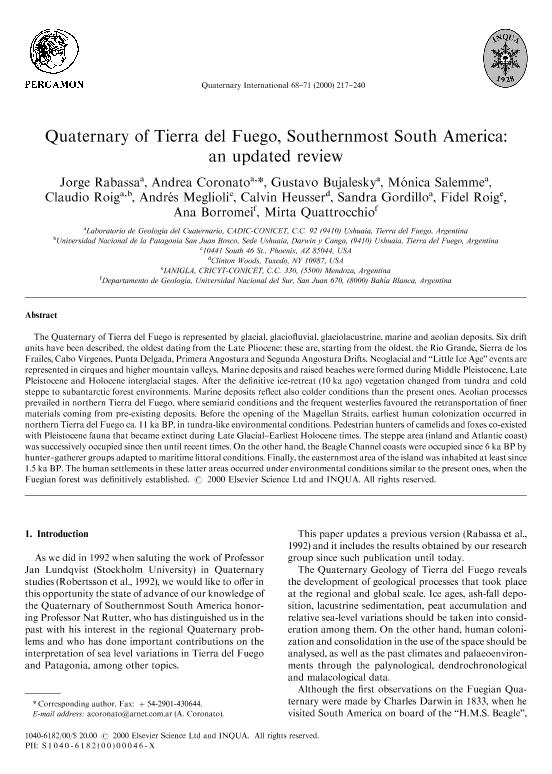Artículo
Quaternary of Tierra del Fuego, Southernmost South America: an updated review
Rabassa, Jorge Oscar ; Coronato, Andrea Maria Josefa
; Coronato, Andrea Maria Josefa ; Bujalesky, Gustavo Gabriel
; Bujalesky, Gustavo Gabriel ; Salemme, Monica Cira
; Salemme, Monica Cira ; Roig, Claudio; Meglioli, Andrés; Heusser, Calvin; Gordillo, Sandra
; Roig, Claudio; Meglioli, Andrés; Heusser, Calvin; Gordillo, Sandra ; Roig Junent, Fidel Alejandro
; Roig Junent, Fidel Alejandro ; Borromei, Ana Maria
; Borromei, Ana Maria ; Quattrocchio, Mirta Elena
; Quattrocchio, Mirta Elena
 ; Coronato, Andrea Maria Josefa
; Coronato, Andrea Maria Josefa ; Bujalesky, Gustavo Gabriel
; Bujalesky, Gustavo Gabriel ; Salemme, Monica Cira
; Salemme, Monica Cira ; Roig, Claudio; Meglioli, Andrés; Heusser, Calvin; Gordillo, Sandra
; Roig, Claudio; Meglioli, Andrés; Heusser, Calvin; Gordillo, Sandra ; Roig Junent, Fidel Alejandro
; Roig Junent, Fidel Alejandro ; Borromei, Ana Maria
; Borromei, Ana Maria ; Quattrocchio, Mirta Elena
; Quattrocchio, Mirta Elena
Fecha de publicación:
06/2000
Editorial:
Pergamon-Elsevier Science Ltd
Revista:
Quaternary International
ISSN:
1040-6182
Idioma:
Inglés
Tipo de recurso:
Artículo publicado
Clasificación temática:
Resumen
The Quaternary of Tierra del Fuego is represented by glacial, glaciofluvial, glaciolacustrine, marine and aeolian deposits. Six drift units have been described, the oldest dating from the Late Pliocene: these are, starting from the oldest, the Río Grande, Sierra de los Frailes, Cabo Vírgenes, Punta Delgada, Primera Angostura and Segunda Angostura Drifts. Neoglacial and ?Little Ice Age? events are represented in cirques and higher mountain valleys. Marine deposits and raised beaches were formed during Middle Pleistocene, Late Pleistocene and Holocene interglacial stages. After the definitive ice-retreat (10 ka ago) vegetation changed from tundra and cold steppe to subantarctic forest environments. Marine deposits reflect also colder conditions than the present ones. Aeolian processes prevailed in northern Tierra del Fuego, where semiarid conditions and the frequent westerlies favoured the retransportation of finer materials coming from preexisting deposits. Before the opening of the Magellan Straits, earliest human colonization occurred in northern Tierra del Fuego ca. 11 ka BP, in tundra-like environmental conditions. Pedestrian hunters of camelids and foxes co-existed with Pleistocene fauna that became extint during Late Glacial-Earliest Holocene times. The steppe area (inland and Atlantic coast) was successively occupied since then until recent times. On the other hand, the Beagle Channel coasts were occupied since 6 ka BP by hunter-gatherer groups adapted to maritime littoral conditions. Finally, the easternmost area of the island was inhabited at least since 1.5 ka BP. The human settlements in these latter areas occurred under environmental conditions similar to the present ones, when the Fuegian forest was definitively established.
Palabras clave:
Geology
,
Quaternary
,
Tierra del Fuego
Archivos asociados
Licencia
Identificadores
Colecciones
Articulos(CADIC)
Articulos de CENTRO AUSTRAL DE INVESTIGACIONES CIENTIFICAS
Articulos de CENTRO AUSTRAL DE INVESTIGACIONES CIENTIFICAS
Articulos(CICTERRA)
Articulos de CENTRO DE INVEST.EN CS.DE LA TIERRA
Articulos de CENTRO DE INVEST.EN CS.DE LA TIERRA
Articulos(IANIGLA)
Articulos de INST. ARG. DE NIVOLOGIA, GLACIOLOGIA Y CS. AMBIENT
Articulos de INST. ARG. DE NIVOLOGIA, GLACIOLOGIA Y CS. AMBIENT
Articulos(INGEOSUR)
Articulos de INST.GEOLOGICO DEL SUR
Articulos de INST.GEOLOGICO DEL SUR
Citación
Rabassa, Jorge Oscar; Coronato, Andrea Maria Josefa; Bujalesky, Gustavo Gabriel; Salemme, Monica Cira; Roig, Claudio; et al.; Quaternary of Tierra del Fuego, Southernmost South America: an updated review; Pergamon-Elsevier Science Ltd; Quaternary International; 68-71; 6-2000; 217-240
Compartir
Altmétricas



